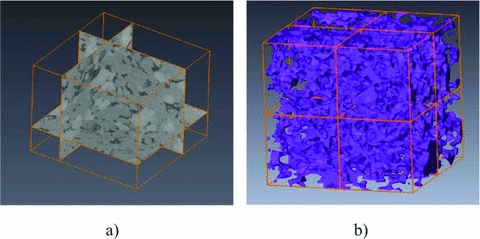Computational elastic upscaling of sandstone on the basis of X‐ray micro‐tomographic images
Up‐scaling the elastic properties of digitized rock volumes as obtained from X‐ray computer tomography (CT) imaging via computer simulations has the potential to assist and complement laboratory measurements.

This computational up‐scaling approach remains a challenging task as the overall elastic properties are not only dependent on the elastic properties of individual grains but also on the hardly resolvable pore spaces between adjacent grains such as micro‐cracks. We develop a digitized rock image and elastic up‐scaling workflow based on general‐purpose and widely available software packages. Particular attention is paid to CT image processing including filtering, smoothing and segmentation. A strategy for optimal meshing for subsequent finite‐element modelling is also proposed. We apply this workflow to the micro‐tomographic image of a well‐consolidated, feldspatic sandstone sample and determine the up‐scaled bulk and shear moduli. These effective elastic moduli are compared to the moduli inferred from laboratory ultrasound measurements at variable effective stresses (0–70 MPa). We observe that the numerically up‐scaled elastic moduli correspond to the moduli at a certain effective stress level (50 MPa), beyond which the effective‐stress dependency follows a linear trend. This indicates that the computational up‐scaling approach yields moduli as if all compliant (soft) porosity was absent, i.e., microcracks are closed. To confirm this hypothesis, we estimate the amount of soft porosity on the basis of the double‐porosity theory (Shapiro, 2003) and find that at 50 MPa the soft porosity is indeed practically zero. We conclude that our computational elastic up‐scaling approach yields physically consistent effective moduli even if some geometrical features are below CT resolution. To account for these sub‐resolution features either theoretical or additional computational approaches can be used.